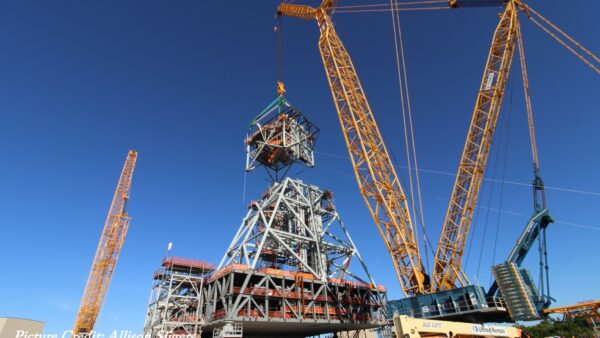American engineering contractor Bechtel has has laid out plans to create a giant offshore “hub port” to rationalise the way the US deals with container traffic. It is presently in talks with the US government over obtaining public subsidy for a facility off the east coast of the country.
The aim would be to create a six-berth facility that is large enough to handle the latest generation of supersized freight carriers (pictured). Containers from these vessels would be transhipped to conventional freighters and taken to ports along the eastern seaboard. This would avoiding the need to redesign the ports to deal with ever bigger ships.
Marco Pluijm, Bechtel’s ports sector manager, says that this strategy would reduce overall shipping costs in the US by up to 40% because it would reduce the distances that containers are transported overland and avoid the need to redevelop existing ports.
It is better to bring the port to the ship instead of dredging channels and bringing the ship to the port– Marco Pluijm, Bechtel
He argues that 70% of containers arriving from Asia at the US west coast ports need to be shipped overland to the east coast, where demand for the goods is greatest.
“If these containers shifted from overland transport to all-water direct import via the Suez Canal to an offshore port, significant savings would be possible,” he said. “All the economic assessments that we’ve done indicate that it is better to bring the port to the ship instead of dredging channels and bringing the ship to the port.”
The idea of a hub port is not in itself a new one. The Chinese have long pursued a strategy of building offshore ports that are able to deal with very large container carriers. It has already constructed a $500m terminal in the Sri Lankan capital of Colombo and a $450m deepwater port at the southern city of Hambontota, which opened in July 2012. These will allow China more easily to export to the growing Indian market while remaining outside Indian jurisdiction.
China is also planning to develop its own hub port off the coast of the US, which would put it in direct competition with any US project. On Monday, the China Harbour Engineering Company confirmed that it is close to completing its research and assessments and should be able to provide additional details of its construction programme in another couple of months.
Many US ports are equipped to handle Panamax ships, but only a few are able to handle the Post Panamaxes that will become more common after the Panama canal is upgraded.
The kinds of difficulties that the new ships will bring are illustrated by the Bayonne Bridge in New York. The deck of the bridge will have to be raised 65 feet to accommodate post Panamax ships, but despite being planned for the past four years, the $1.3bn project has only just begun, and is struggling to make progress against a steady stream of legal challenges.
Once the Nicaragua canal is constructed, ports may be faced with ships that are considerably larger than the Post Panamaxes, such as Capesize and Valemax bulk carriers, which are too large for the Suez canal, and the latest generation of Maersk freighters, which carry 18,270 containers, compared with the 4,300 containers carried by the first Post Panamax vessel.






